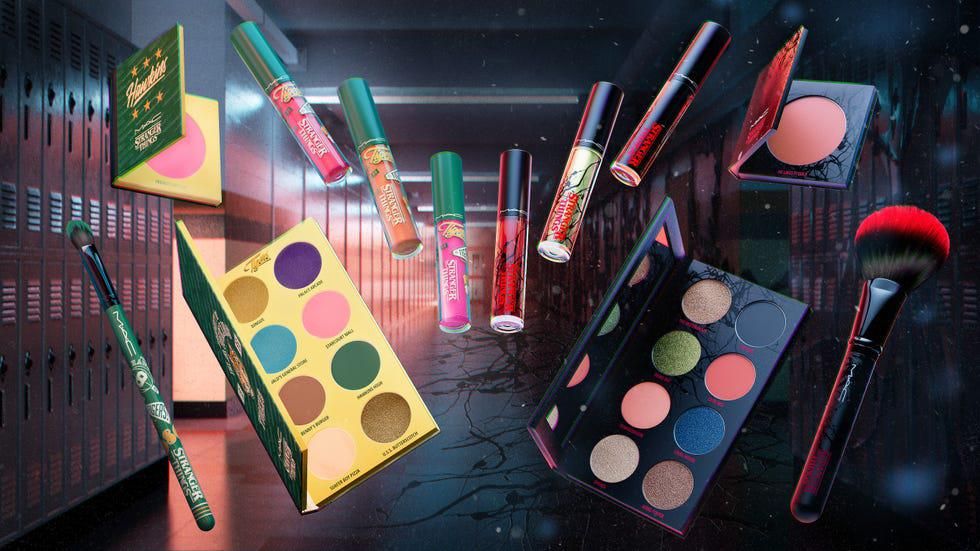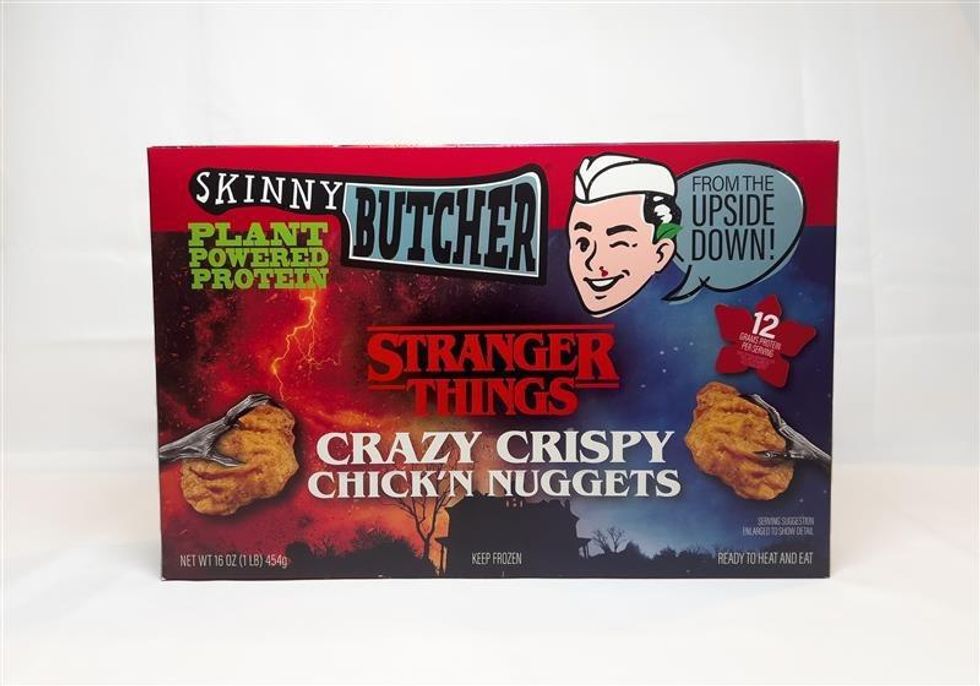Marketing
19 May 2022
Stranger Things counts down to Season 4 with brand collaborations
Netflix teamed with M·A·C Cosmetics, Dominos and Doritos to promote the hit show.

Netflix teamed with M·A·C Cosmetics, Dominos and Doritos to promote the hit show.

The new season of Stranger Things is coming May 27. But before that, fans can interact with the show while ordering pizza, putting on makeup and buying Doritos.
As the fourth season of the hit streaming sci-fi-horror drama, approaches, Netflix is rolling out a series of brand collaborations to draw the public's attention. But it's not just putting the Stranger Things name on products. It's creating new ways to interact with the show, and its characters.
Let’s take a look at the recent drops:

(Image: Domino's)
Domino’s and Netflix went into the lab to create a new app.
The new Mind Ordering app is designed to place subjects inside Hawkins National Lab, the secretive government lab from the show. In this immersive environment, they can explore the lab and discover the Noid or Demogorgon along the way.
But users can really turn it up to Eleven by ordering pizza without even pressing a button. Thanks to facial recognition and eye-tracking technology, users can make gestures and expressions to place a Domino’s order. Taking things one step further into the show, a pizza ordered with the app is delivered in a retro Domino’s box.
Domino’s and Netflix also rolled out a landing page for the app, complete with a backstory video featuring Dustin and Lucas.

(Photo: M·A·C Cosmetics)
Stranger Things now has its own makeup collection thanks to a collab with the beauty brand M·A·C Cosmetics.
Though all roads lead to ‘80s looks for this collab, it has a choose-your-own-adventure feel. Users can pick between the human world and the upside down world, or choose between the Hawkins Class of 1986 palette and the Void Eye Palette. It also has shades specific to the show. M·A·C’s famous Lipglass has Eerie El, while powder blush offers a shade called Friends Don’t Lie.
“Coming of age in a small town in the 80s, I completely relate to the vibe and characters of Stranger Things,” Fatima Thomas, M·A·C senior artist, said in a news release. “This collaboration perfectly captures the essence of the era: spirited, adventurous and fun.”
The limited edition collection is available at Ulta Beauty, Ulta’s website, and M·A·C’s website.

(Photo: Doritos)
You’ve got the makeup and ordered a pizza. Now you’re ready to take in a virtual concert.
This tie-in with Doritos features activations on multiple levels. There’s limited edition packaging of Doritos and Doritos 3D Crunch that’s particular to Stranger Things. There’s also a limited edition flavor for the occasion. Dubbed Doritos 3D Crunch Three Cheese, it mixes cheddar, Monterey Jack and parmesan cheese.
But these bags are not merely a vessel for chips. They are also a portal through which fans can reserve a ticket for "Live From The Upside Down,” a virtual concert that is set to be held on June 23. It features 80s stars The GoGo’s, Soft Cell and Corey Heart performing their classic material from the era. Plus, one of the bands will perform with current pop icon Charlie XCX.
As with the Domino’s collab, this also has a backstory. Per Domino’s press release:
The story goes that back in 1986, a tour bus crashed near Hawkins, Ind., headed to Doritos Music Fest '86 – the greatest concert that never happened. The musicians disappeared into another dimension and the show was canceled… until now.

(Photo: Skinny Butcher)
The plant-based trend in food can't be overlooked, even when it comes to streaming TV activations. Skinny Butcher rolled out a line of Stranger Things-themed plant-based nuggets ahead of the new season, making the vegan eats available at Walmart stores nationwide. It's a chance for the brand to tout its Crazy Crispy Chick'n Nuggets, which replace chicken with pea protein and a progressive vegetable fiber strain. It gives Stranger Things a place in the freezer section, and appeals to those who are opting for a meat alternative.
It's also a chance to bring noteriety to the brand itself, which is the result of a collaboration between former Garden Fresh Gourmet Vice Chairman Dave Zilko and the Los Angeles-based Golden West Food Group.
"No secret experiments were conducted here – just some ingenuity from the team at Golden West Food Group!" Zilko quipped in the announcement.
For one, Netflix is putting lots of marketing resources behind Stranger Things’ latest season. For another, its team is getting creative, and the teams at some big brands are right there with them, ready to do something new.
Going a level deeper, these collaborations show how marketing doesn't have to limit brands to a single category. A promotion for a streaming TV show is crossing into food and beauty. It’s bringing in tech, music and retail. Each individual partnership in turn offers a way for Stranger Things to reach a unique audience. After all, the Venn diagram overlap between the Doritos crowd and the Skinny Butcher crowd probably isn't too big. With each collaboration, Netflix in turn creates additional mediums where Stranger Things is represented, making it seem ubiquitous.
These collaborations also show brand strength for Stranger Things itself. To have the leeway to create these new experiences, a brand must already be recognizable enough to build around.
Stranger Things’ brand has a pair of elements, which play off each other. For one, it has recognizable characters and vocabulary that brands can have fun with. Zilko's quote was just one of many examples of cheeky comments in press releases for these collaborations.
The show is also highly associated with 80s nostalgia. This is present throughout these collaborations, with the vintage pizza box, mall-era makeup shades and, of course, the 80s bands playing at the virtual concert.
It’s this blend of the recognizable and the new that has driven success for Stranger Things to date.
Stranger Things’ marketing has gotten attention in its own right before with an interactive billboard, an off-menu Demogorgon Frappuccino at Starbucks and an unexpected boost for Eggo waffles. With collaborations that bring together other brands and interactive media, it continues to break new ground.On the Move has the latest from Amazon, Lovesac and more.
Ryan Cohen is executive chairman of GameStop. (Photo by Flickr user Bill Jerome, used under a Creative Commons) license.
This week, leadership is changing at GameStop, Sorel and Beautycounter. Meanwhile, key executives are departing at Amazon, Wayfair and Lovesac.
Here’s a look at the latest shuffles:
GameStop announced the termination of Matthew Furlong as CEO on Wednesday. A brief statement did not provide a reason for the firing.
With the move, Chewy founder and activist investor Ryan Cohen was named executive chairman of the video game retailer. Cohen will be responsible for capital allocation and overseeing management.
It came as the company reported a 10% year-over-year decline in net sales for the first quarter. Meanwhile, the company’s net loss improved by 62%.
In an SEC filing, GameStop further added this “We believe the combination of these efforts to stabilize and optimize our core business and achieve sustained profitability while also focusing on capital allocation under Mr. Cohen’s leadership will further unlock long-term value creation for our stockholders.”
Cohen was revealed as GameStop's largest shareholder when he disclosed a 10% stake in the retailer in 2020. GameStop went on to become a leading name in the meme stock rise of 2021.
Mark Nenow is stepping down as president of the Sorel brand in order to focus on his health.
After rising to the role in 2015, Nenow spearheaded a transformation of Columbia Sportswear-owned Sorel from a men’s workwear brand to a fashion-focused brand that led with a women’s offering of boots, sandals and sneakers.
“Mark led the brand to sales of $347 million in net sales in 2022,” said Columbia Sportswear CEO Tim Boyle, in a statement. “His leadership has been invaluable to this company, and we wish him the very best.”
Columbia will conduct a search for Nenow’s replacement. Craig Zanon, the company’s SVP of emerging brands, will lead Sorel in the interim.
Beautycounter appointed board member Mindy Mackenzie as interim CEO, succeeding Marc Rey. According to the brand, Rey and the board “mutually decided to transition to a new phase of leadership for Beautycounter.”
McKenzie, a former executive at Carlyle, McKinsey and Jim Beam, will lead the company as it conducts a search for a permanent CEO. Additionally, former Natura & Co CEO Roberto Marques will join Beautycounter’s board as chair.
As part of the transition, Nicole Malozi is also joining the company as chief financial officer. She brings experience from Tatcha, Nike, and DFS Group Limited.
Melissa Nick, a VP of customer fulfillment for North America at Amazon, will leave the company, effective June 16, CNBC reported. Nick joined the company in 2014, and oversaw a region that included nearly 300 fulfillment centers. After doubling its supply chain footprint during the pandemic, Amazon recently reorganized its fulfillment operations to take a regional approach, as opposed to a national model that often resulted in items shipping across the country.

Jon Blotner (Courtesy photo)
Steve Oblak will retire from the role of chief commercial officer at home goods marketplace Wayfair. With the move, Jon Blotner will be promoted to chief commercial officer.
"Steve has served as a critical part of our leadership team and played a pivotal role in Wayfair's growth, helping us grow from a $250 million business when he joined to $12 billion in net revenue today,” said Wayfair CEO Niraj Shah, in a statement. “He oversaw countless milestones, from helping to launch the Wayfair brand as we brought together hundreds of sites into a single platform, to launching new categories, business lines, and geographies while overseeing our North American and European businesses, to leading our debut into physical retail.”
Blotner previously oversaw exclusive and specialty retail brands, as well as digital media at Wayfair. Before joining the company, he served as president of Gemvara.com prior to its 2016 acquisition by Berkshire Hathaway.
Furniture retailer Lovesac said Donna Dellomo will retire as EVP and CFO, and move to an advisory role, effective June 30. Dellomo was with Lovesac for six years.
Keith Siegner was appointed as the next EVP and CFO. He brings experience as CFO of esports company Vindex, as well as executive roles at Yum! Brands, UBS Securities and Credit Suisse.
Additionally, Jack Krause will retire from the role of chief strategy officer, effective June 30. His responsibilities will be divided between CEO Shawn Nelson and president Mary Fox.
“Since joining Lovesac, Jack has played an instrumental role in transforming the Company into a true omni channel retailer by helping expand our physical touchpoints and digital platform as we continue to disrupt the industry,” said Nelson, in a statement.
The National Retail Federation announced the addition of five new board members. They include: